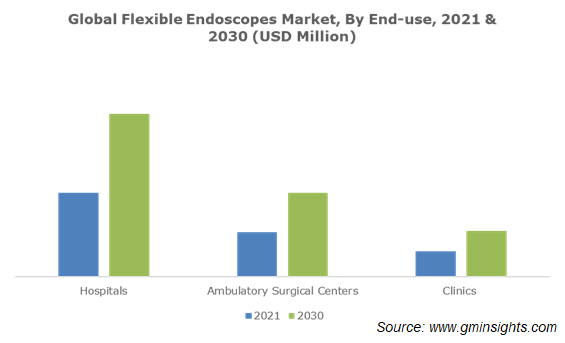Home > Healthcare > Medical Devices > Diagnostic Devices > Flexible Endoscopes Market
Flexible Endoscopes Market Analysis
- Report ID: GMI5194
- Published Date: Aug 2022
- Report Format: PDF
Flexible Endoscopes Market Analysis
In terms of segmentation by product, the market is bifurcated into video endoscope and fiberscope categories. Of these, the video endoscope segment held 64% of the flexible endoscopes industry share in 2021 and will be valued at over USD 6,900 million by 2030. This product is widely used in diagnostic applications, including the endoscopic examination of the esophagus, and can function as a mobile and convenient solution across hospital settings. The popularity of video endoscopes is further attributable to the high awareness of their benefits in the early diagnosis of chronic diseases, including ulcers, digestive tract bleeding, and gastritis.
Based on the application spectrum, the flexible endoscopes market is divided into GI endoscopy, ENT endoscopy, urology, pulmonary endoscopy, and others. The pulmonary endoscopy segment among these is set to witness depict a 7.5% CAGR through 2030. This growth is attributed mainly to an increase in the number of patients with respiratory diseases like chronic obstructive pulmonary disease (COPD), asthma, and lung cancer. According to the CDC’s data, COPD impacts around 15 million people across the U.S. This high disease prevalence will escalate the use of different types of flexible endoscopes in pulmonary procedures.

With regards to end-user, the flexible endoscopes market is divided into hospitals, clinics, and ambulatory surgical centers. Hospitals are adopting novel flexible endoscopes to rapidly deliver reliable test results. A wide range of technologically advanced flexible endoscopes with proven accuracy has also been made available to perform disease treatment procedures across hospital settings. These factors could drive the market demand from the hospitals segment, which is likely to register revenue over USD 5,800 million by 2030.

On the regional front, the North America flexible endoscopes market is anticipated to record a revenue of more than USD 4,500 million by 2030. This can be credited to the expanding geriatric population, often susceptible to chronic diseases. A robust presence of key manufacturers is also observed across the region, resulting in the accelerated production of advanced endoscopes. Varied supportive initiatives to strengthen healthcare infrastructure and increase in chronic disease awareness are also stimulating the regional industry share.

